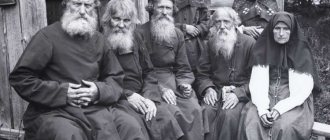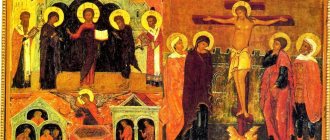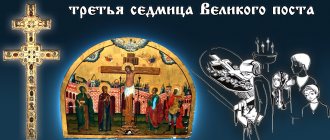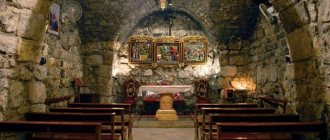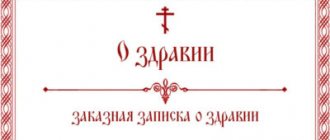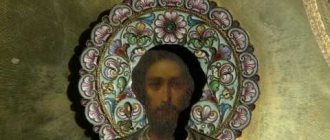- Theopaschite disputes Mikhail Oksiyuk
- Perichoresis
***
Theopaschite expressions (from the Greek Θεός [Theos, late Greek Theos], God and πάσχω [Easter], I suffer) are religious formulas about the suffering of the God-man Jesus Christ, in which the mutual movement of names is seen, when the human is designated as the Divine, and The Divine as Human (example: “God suffered on the Cross”).
For example: “The Word of God suffered in the flesh and was crucified in the flesh and death tasted in the flesh” (3rd Ecumenical Council) “One of the Trinity suffered in the flesh” (the position of the Scythian monks), “You were crucified, O Christ God” (troparion of St. Justinian “ Only Begotten Son...").
Theopaschytic expressions reflect the mutual communication of the properties of the Divine and human natures in the single hypostasis of Jesus Christ.
***
How to choose a cross for a monument
There were and are a huge number of crosses in the world: the ancient Egyptian Ankh, the Celtic cross, the solar, Latin, Orthodox, Byzantine, Armenian (“blooming”), St. Andrew’s and other crosses - these are all geometric symbols used in different eras and in modern times to express different meanings. Most crosses are somehow connected with Christianity.
In the Christian tradition, the veneration of the cross originates from the legend of the martyrdom of Jesus Christ. Execution by crucifixion existed before Christ - this is how robbers were usually crucified - however, in Christianity, the cross takes on the meaning not only of an instrument of execution, but of the salvation of Christians through the death of Jesus.
To decide on the choice of a monument in the form of a cross, you need to understand the difference between their different types. Considering that the majority of Belarusians identify themselves with Christianity, we will dwell in more detail on the types of Christian crosses used on the territory of Belarus.
REDEEMED!
Secondly,
the word
tetelestai
was the equivalent of the Hebrew word spoken by the high priest at the moment of sacrificing a lamb without spot or blemish. Each year, the high priest entered the Holy of Holies, where he sprinkled the blood of the spotless sacrificial lamb on the mercy seat of the Ark of the Covenant. The moment the blood touched the lid of the Ark, the people were cleansed of their sins in one year. And a year later, the high priest again entered the veil of this sacred room and sacrificed blood. This ritual was performed year after year to obtain annual, temporary forgiveness of sins.
But when Jesus hung on the Cross, He was both the Lamb and the High Priest. At this holy moment, our Great High Priest Jesus offered His own blood for eternal cleansing from sin. He offered the perfect sacrifice, of which every sacrifice under the law of Moses was a symbol and type. From this point on, sin sacrifices were no longer required. Jesus entered the Holy of Holies and offered His Own blood—and that was enough. People no longer needed to offer the blood of lambs to God to receive forgiveness for their sins. This is stated in Hebrews 9:12:
“And not with the blood of goats and bulls, but with His own blood, He entered once into the sanctuary and obtained eternal redemption.”
Thus, when Jesus said, “It is finished!”
– He thereby proclaimed the end of the period of sacrifices, because the final Sacrifice had finally been made!
The atonement was complete and fully fulfilled.
It happened once and for all –
finally!
Varieties of Christian crosses
In the early Christian Eastern Church, about 16 types of crosses were common. Each of the crosses is revered by the church, and, as the priests say, a cross of any shape is as holy as the tree on which the Savior was crucified.
The most common types of crosses in Belarus:
- Six-pointed Russian Orthodox cross
- Eight-pointed Orthodox (cross of St. Lazarus)
- Eight-pointed cross - Golgotha
- Four-pointed Latin (or Catholic). Alternatively, this is also an Orthodox cross.
What is the difference between these crosses?
Six-pointed Russian cross
The six-pointed Russian cross is a cross with one horizontal crossbar and a lower inclined one.
This form of the cross exists in Orthodoxy along with the eight-pointed one, being, in fact, its simplified form. However, it should be noted that the spread of this type of cross is more typical for Belarus. In Russia, you can find an eight-pointed Orthodox cross much more often.
The lower crossbar of the six-pointed Russian cross symbolizes the footrest, a detail that took place in reality.
The cross on which Christ was crucified was four-pointed. Another crossbar at the feet was attached to the cross before placing the cross in a vertical position, after the crucifixion, when the place on the cross where the feet of the crucified person were located became obvious.
The inclination of the lower crossbar has the symbolic meaning of “the measure of righteousness.” The higher part of the crossbar is located on the right side. At the right hand of Christ, according to legend, a repentant and therefore justified thief was crucified. On the left side, where the crossbar faces down, a robber was crucified, who by blaspheming the Savior further aggravated his situation. In a broad sense, this crossbar is interpreted as a symbol of a person’s state of mind.
Eight-pointed cross
The eight-pointed cross is a more complete form of the Orthodox cross.
The upper crossbar, which distinguishes the cross from the six-pointed one, symbolizes the tablet with the inscription (title), which was nailed to the cross also after the crucifixion, by order of Pontius Pilate, the Roman prefect of Judea. Partly in mockery, partly to indicate the “guilt” of the crucified man, the tablet read in three languages: “Jesus of Nazareth, King of the Jews” (I.N.C.I.).
Thus, the meaning of the six-pointed and eight-pointed crosses is the same, but the eight-pointed cross is more rich in symbolic content.
Eight-pointed cross-Golgotha
The most complete type of Orthodox cross is the Golgotha cross. This symbol contains many details that reflect the meaning of Orthodox doctrine.
The eight-pointed cross stands on a symbolic image of Mount Golgotha, on which, as it is written in the Gospel, the crucifixion of Christ took place. To the left and right of the mountain are the letter signatures of G.G. (Mount Golgotha) and M.L. R.B. (Place of Execution Crucified Byst or, according to another version, Place of Execution Paradise Byst - according to legend, at the site of the execution of Christ there was once Paradise and the forefather of humanity, Adam, was buried here).
Under the mountain there is a skull and bones - this is a symbolic image of the remains of Adam. Christ “washed” his bones with his blood, saving humanity from original sin. The bones are arranged in the order in which the hands are folded during communion or burial, and the letters G.A. located near the skull indicate the words Head of Adam.
To the left and right of the cross are depicted the instruments of Christ’s execution: on the left is a spear, on the right is a sponge with the corresponding letter signatures (K. and G.). According to the Gospel, a warrior brought a sponge on a cane, soaked in vinegar, to Christ’s lips, and another warrior pierced his ribs with a spear.
Behind the cross there is usually a circle - this is the crown of thorns of Christ.
On the sides of the cross of Golgotha there are inscriptions: Isa. Xs. (short form of Jesus Christ), King of Glory, and Ni Ka (meaning Conqueror).
As you can see, the Golgotha cross is the most complete form of the Orthodox Christian cross in terms of symbolic content.
Four-pointed cross
The four-pointed cross is one of the most ancient variants of Christian symbolism. The cross of the Armenian Church, in which Christianity was recognized as the state religion for the first time in the world at the beginning of the 4th century AD, was and remains four-pointed.
In addition, crosses not only on ancient, but also on the most famous Orthodox cathedrals have a four-pointed shape. For example, at the Cathedral of Hagia Sophia in Constantinople, the Assumption Cathedral in Vladimir, the Transfiguration Cathedral in Pereslavl, and the Peter and Paul Orthodox Church in St. Petersburg. If we talk about Belarus, then a four-pointed cross with a crescent can be seen on the dome of the Church of St. Elisabeth Monastery in Novinki. The crescent on the cross, according to different versions, symbolizes the anchor (the Church as a place of salvation), the Eucharistic Chalice, the cradle of Christ or the baptismal font.
However, if in Orthodox churches the four-pointed form of the cross is not often found, then in the Catholic Church only one version of the cross is used - the four-pointed one, otherwise called the Latin cross.
When choosing a cross for a monument to a deceased person who professed the Catholic faith, it is best to choose a four-pointed Latin cross.
History of theopaschite formulas
The history of theopaschytic formulas is connected with the Scythian monks who arrived in Constantinople in 519 with accusations of unorthodoxy against their bishops. Among these monks there were outstanding theologians - Leontius of Jerusalem and John Maxentius. They demanded that the formula “One of the Trinity suffered in the flesh” (unum de Trinitate crucifixum esse) be added to the definitions of the Council of Chalcedon.
At first, their formula met with opposition from Emperor Justinian. But gradually it was supported by the bishops and the pope, and the emperor himself in 533 not only issued an edict in its support, but also became the author of the theopaschite troparion “The Only Begotten Son...”. Justinian accurately expressed the doctrine of the communion of properties in Christ with the words: “neither miracles without the flesh, nor suffering without the Divinity.”
***
Classical theopaschism: “For if they had known, they would not have crucified the Lord of glory ,” for in Him dwells all the fullness of the Godhead bodily... (1 Cor. 2:8).
"3. If anyone says that the Word of God, who performed miracles, is not the same Christ who suffered, or that God the Word was united with Christ, born of a Woman, or that in Him there is, as it were, a being in another, different being, and that this is not one and the same Lord Jesus Christ, the Word of God, Incarnate and became man, to Whom belong the miracles and sufferings that He voluntarily endured in the flesh , may He be excommunicated from the community of the faithful... 10. If anyone does not confess that He, Whoever was crucified in the flesh, our Lord Jesus Christ, is the true God, the Lord of glory and one of the Holy Trinity, may he be excommunicated from the community of the faithful.” Fifth Ecumenical Council
“If anyone does not confess that He who was crucified in the flesh, our Lord Jesus Christ, is the true God, the Lord of glory and one of the Holy Trinity , let him be excommunicated from the community of the faithful.” II Council of Constantinople (V Ecumenical Council)
“ Whoever does not confess that God the Word suffered in the flesh, was crucified in the flesh, received death in the flesh , and finally became the firstborn from the dead, since He is life and life-giving as God, let him be anathema.” St. Cyril of Alexandria. Explanation of 12 chapters, Anathematism 12
“Although the Word of God the Father is dispassionate and immortal, because the divine and intact nature is higher than suffering and itself gives life to everything and is higher than corruption and everything that can suffer, nevertheless, being such in essence, the Word of God the Father assimilated flesh capable of death, so that through the one who can suffer, taking upon himself suffering in our place and for us , and deliver us all from death and corruption, having given life, as God did his own body and the firstfruits of the dead (1 Cor. 15:20) and was the firstborn from the dead (Col. .1:18). For the one who lifted up the honorable cross for us and tasted death was not some ordinary person, considered by himself and separately from the Word of God the Father, but the Lord of glory Himself suffered in the flesh, according to the Scriptures. And since those who want to mix empty and wicked opinions with the right and immaculate faith say that an ordinary person lifted the cross for us, it became necessary to anathematize, revealing the greatness of their wickedness.” St. Cyril of Alexandria Explanation of the 12 chapters, set forth in Ephesus, when the Holy Council demanded their clearest presentation
“So, in fact, there were: the conception of God from the Virgin, His birth, His similarity with us in everything, His suffering, preaching in darkness and the canopy (to those sitting), His Resurrection and, finally, ascension into heaven. The Incontainable One, having received flesh from Mary, determines to be imprisoned in a virgin’s womb. The infinite is contained by the flesh. The unchangeable takes on human form. The impassive one suffers for us and for us with his flesh . He who abides inseparably with God and the Father on earth, according to Scripture, appeared and lived with men (Bar.3:38). The untouchable is pierced by a spear from the wicked. The dispassionate one voluntarily bears the cross for us. The immortal light is subject to death on the cross . Having been in the bosom of the Father, He does not refuse to ascend with His flesh to heaven.” St. Cyril of Alexandria. On the Incarnation of God the Word
“The Divine Logos, being all a complete essence, for He is God, and all a hypostasis, not lacking, for He is the Son, but having exhausted Himself, became the seed of His flesh, formed with it by ineffable conception, and became a hypostasis for the received flesh. And through this new sacrament, truly and immutably, having become completely human, He Himself appeared as a hypostasis from two natures, uncreated and created; impassive and passionate, and without exception, all the natural laws of nature, from which His hypostasis, appeared to those who applied it to Himself. If He essentially accepted all the natural (from which His hypostasis is natural) laws, despite the fact that He Himself became complex in hypostasis from taking on the flesh, the teacher very wisely, so that they would not be considered in vain, attached the passions of His flesh to Him (after all, it is His own flesh) to those who exist according to it, truly God, suffering [in the struggle] against sin .” Venerable Maximus the Confessor On various perplexities of Saints Dionysius and Gregory (Ambigva to Thomas)
“Orthodox theopaschism is rooted not just in Chalcedon, but in the doctrine of the omnipresent and all-pervading Energies of God. For, since the Divinity tends to penetrate into everything and extend itself with the nature of beings in every part (nothing can remain in being without existing in existence), in fact, what originally exists is God’s nature, which, of necessity, forces us to believe that It is in all beings, the very existence of beings), then from the cross, which, according to its external appearance, is divided into four parts, so that from the middle in which it mates with itself, the four ends are counted, we learn that during the mortal dispensation the One who He connects and conforms everything with Himself, bringing the various natures of beings into one harmony and harmony . For in beings something else appears either above or below, or the thought goes to what is on the outside limits.” St. Gregory of Nyssa. Great Announcement, Chapter 32
“And a weapon will pierce your very soul,” Simeon further said to the Mother Virgin: “let the thoughts of many hearts be revealed” (Luke 2:35), that is, your soul, struck by amazement and fear, will be pierced as if by a sword when you You will see Him voluntarily nailed to the cross and hanging among the thieves, in order to kill the death by which we were killed, to give us life and to free man from the bonds of sin with which the devil had bound him since ancient times. For how could God, who by nature can neither die nor suffer, be crucified on the cross? How did He, who was surrounded by the constant praise of angels, end up among the reproaches of robbers? How does He who gives food to all who are hungry and drink to those who are thirsty drink gall and ocet? How does Life Itself, which gives life to all who love it, accept death and then burial? You, Virgo, will be amazed to see this, and a weapon will pierce your soul. But you will not remain in this state, and the sword will very soon be torn out of your soul. The thoughts of many hearts will be revealed to those who cannot perceive Your divine and wondrous mysteries, Virgin, and contemplate the heavenly virtues.” St. Sophronius of Jerusalem († c. 638). Word for the Presentation of the Lord
“For if they themselves had sincerely penetrated with their minds into the Divinity of Christ, they would not have mocked so much; but on the contrary, the world would know this Savior, they would know that in the cross there is no harm, but healing for the creature. If with the appearance of the cross all idolatry is destroyed, and with the sign of the cross all demonic dreams are driven away; if Christ alone is worshiped, and through Him the Father is known; if those who contradict are put to shame, and every day Christ invisibly bows to Himself the souls of those who contradict; then we have the right to say to the pagans: how can this matter be recognized as human, and not moreover confess that He who ascended to the cross is God’s Word and the Savior of the world ?” St. Athanasius the Great. Word to the Gentiles
“Therefore your faith is vain; for your wisdom is like the wisdom of the wicked Arians; and you understand poorly what is said: The Word became flesh. The Word was not made flesh so that the Word would no longer be the Word; but in order for the Word to be in the flesh, It became flesh: that is, so that the Word could always be the Word, and have flesh, in which God the Word accepted in human form suffering and death , descending to the grave and hell, in which He committed and the resurrection from the dead, having presented the evidence of flesh, blood and soul in one’s own and unseparated flesh, according to what is written, from the seed of David.” St. Athanasius the Great Against Apollinaris. Book 1. On the Incarnation of Our Lord Jesus Christ
“He is unreasonable who does not give equal Divine honor to the King, the ever-bearing Word of God, with the heavenly Father; The one who does not give equal Divine honor to the heavenly Word to the King-Word, who appeared on earth in human form, is also unreasonable, but separates either the Word from the great Father, or from the Word the human image and our dullness. Why was the word God, but became our man, so that, uniting with the earthly, he could unite God with us. To both it is one God; Because man, because he makes me a god from a man. Be merciful to me, the Almighty, who was angry for me!” St. Gregory the Theologian. About becoming human
“I ask: to whom was the blood of God ?” St. Gregory the Theologian. Against Apollinaris
“Because of this unity of person, which must be understood in relation to both natures, we read about the Son of Man that He “came down from heaven,” while the Son of God took flesh from the Virgin, from whom he was born; and vice versa - it is said about the Son of God that He was “crucified and buried ,” whereas He suffered this not by divinity, according to which the Only Begotten is co-eternal and consubstantial with the Father, but by weak human nature.” St. Leo, Pope of Rome District or conciliar letter written to Flavian, Archbishop of Constantinople (against the heresy of Eutyches)
Difference between Orthodox and Catholic crucifixes
In addition to the difference in the shape of the cross between Eastern and Western Christians, there are also differences in the crucifix itself. Knowing the important distinctive features of Orthodox and Catholic crucifixes, you can easily determine which direction of Christianity this symbol belongs to.
Differences between Orthodox and Catholic crucifixes:
- Number of nails visible in a crucifix
- Position of Christ's body
If in the Orthodox tradition four nails are depicted on the crucifix - for each hand and leg separately, then in the Catholic tradition the legs of Christ are crossed and nailed with one nail, respectively, there are three nails on the crucifix.
Orthodoxy explains the presence of four nails by the fact that the cross on which Christ was crucified, brought by Queen Helena from Jerusalem to Constantinople, had traces of four nails.
Catholics justify their version of the three nails by the fact that all the nails of the cross on which Christ was crucified are kept in the Vatican, and there are only three of them. In addition, the image on the Shroud of Turin is printed in such a way that the legs of the crucified man are crossed, therefore it can be assumed that Christ’s legs were nailed with one nail.
The position of the body of Christ on the Orthodox crucifix is a little unnatural; the body of Jesus does not hang on his hands, as it should have happened according to physical laws. On the Orthodox crucifix, Christ’s hands extend along the cross to the sides, as if calling “all the ends of the earth” (Is. 45:22). The crucifix does not attempt to reflect pain, it is more symbolic. Orthodoxy explains such features of the crucifixion by the fact that the cross is, first of all, a weapon of victory over death. The crucifix in Orthodoxy is a symbol of the victory of life over death, and, paradoxically, almost an object of joy, because it contains the idea of the Resurrection.
On a Catholic crucifix, the position of the body is as close as possible to physiological: the body sags in the arms by its own weight. The Catholic crucifixion is more realistic: often depicted bleeding blood, stigmata from nails, spears.
TASK COMPLETED!
Firstly,
this word was used when a servant was sent to perform a certain task, after which he had to return to his master.
Having completed the task, the servant said: “tetelestai” .
This meant:
“I did exactly what you asked me to do”
or
“The task was completed.”
Based on this, the word
tetelestai
meant that at the moment when Jesus exclaimed:
“It is finished,”
He proclaimed to the whole universe that he had exactly fulfilled the will of the Father and His mission was completed.
And it is not surprising that Jesus raised his voice, because this was the greatest victory in the history of mankind! He was faithful to His commission even in the face of unimaginable trials. But now the battle was over, and Jesus could exclaim to the Father: “ I have done exactly what You Me !”
or
“My mission is accomplished!”
"THE GREAT WATERDIVIDUAL"
Fourthly, the word tetelestai
used to describe
a turning point when one period ends and begins .
When Jesus cried,
“It is finished!”
- this, of course, became a turning point in the history of mankind.
This marked the end of the Old Testament - that period was finally completed - and the beginning of the New Testament. The cross became the “Great Divide” in history. When Jesus cried, “It is finished!”
– He declared that the Old Testament had ended and the New Testament had now come into force!
In this Divine moment, all the Old Testament prophecies about the earthly ministry of Jesus were fulfilled. God's justice prevailed and was satisfied by God's Lamb. At this moment, the need for Old Testament sacrifices completely disappeared, because the perfect Sacrifice gave His life for the salvation of all mankind. Jesus' mission was accomplished. And now He could proclaim it to the whole universe!
Because Jesus was willing to offer His own blood as payment for the debt of our sin, we are now forgiven and completely free. And you and I must always remember this. Our past sins are stamped "PAID IN FULL" because Jesus paid for our redemption with the price of His own blood.
The symbol of the cross: meaning and mystical role
The cross is a symbol of man
In Pythagorean numerology, paganism and Egyptian mystery, the cross is a symbol of man. The vertical line denotes the internal axis, immortality, spirit, the union of the divine and the created. The horizontal line of the cross is a symbol of the physical body and its perishability - the law of time. The intersection point is a symbol of the soul, a symbol of the true “I”. The "I" or conscious Atman is the animating fifth element in this system. Therefore, the cross is a symbol of man, like the number five, which is born in the unity of the four elements.
The oblique cross is a symbol of a person stretching out his hands to heaven.
The eight-pointed cross is a symbol of the Cosmic Man , similar to another mystical symbol - the Kabbalistic Tree of Life . According to Kabbalah, this tree is the energetic diagram of the prototype of the human race - Adam Kadmon. In this system, the apex of the cross coincides with the upper coronary chakra, which serves as a connection with the sky. The lower part of the cross coincides with the lower root chakra, responsible for connecting with the earth. The intersection of the lines coincides with the central heart chakra. It serves as a container for the soul and high feelings, experiences, emotions, such as compassion and love. This is also the answer why the cross is a symbol of love for people. For only from this center can we produce true unconditional love.
The relationship between the symbols of the Christian eight-pointed cross and the Kabbalistic Tree of Sephiroth
The red cross is a symbol of medicine
The symbol of the red cross is perhaps the only symbol in this series that does not have a religious background. It was designed as the emblem of the International Red Cross and Red Crescent Movement (ICRC), a service organized to protect and assist victims of emergencies and war. The symbol is a reverse image of the society's homeland - Switzerland. The red crescent is used as an alternative to the red cross by Muslim countries that find the cross unpleasant due to its associations with the crusaders.
Inverted cross
The symbol of the inverted cross is best known as the cross of Satan, expressing mockery of the Christian idea. In addition, it denotes, like the inverted pentagram, the primacy of the material over the spiritual, of earth over heaven. According to mystics, an inverted cross elevates the Devil to God. If God is the top of the cross, and Satan is its bottom, then an inverted cross reverses their hierarchy.
However, there are other versions of the interpretation of this symbol. According to one of them, its other name is Peter's cross or Peter's cross . It takes its origin from the story of Saint Peter, who asked to be crucified on an inverted cross, considering himself unworthy to die like Jesus. Another version is offered by paganism, the meaning of the inverted cross is interpreted here as the hammer of Thor (the thunder god of the German-Scandinavian tribes).
On the left is an inverted cross of Satan, on the right is Thor’s hammer, in the middle is a fragment of the fresco by Filippino Lippi “The Crucifixion of St. Peter”
A cross in a circle is the oldest symbol of the sun
The cross in a circle is a symbol of the sun and solar gods. This ancient sign was very popular already at the very dawn of human development. Pagan peoples believed in the protective power of the sun wheel, worshiped it, decorated their clothes with it, and made amulets with its image.
In the Slavs, a cross in a circle is a symbol of the god Perun, the Thunderer. The Slavs endow him with great strength and power. Tradition claims that the solar cross is a conductor of positive, masculine, active and exclusively light energies.
The solar cross is also found in Hinduism, but it has a slightly different meaning. Indian wisdom interprets a cross in a circle as meaning the Wheel of Samsara - the wheel of life and death, the exit from which in Hinduism is the goal of spiritual practice.
The symbol of a cross in a circle is also found in Celtic symbolism. Another name for it is the Celtic cross. This sign appeared as a result of the fusion of the pagan symbol of the sun and the classical Christian cross, as an attempt to adapt Christianity to pagan symbolism.
Celtic cross - a symbol of the transition from paganism to Christianity
Rose and Cross symbol
The Rosicrucian Order is closely associated with this mystical sign. This is the symbol of the Rose and Cross , which served as an emblem for secret medieval orders. The cross means trials, the rose means the human soul. Such images were found in evidence from much earlier eras: in Ancient Egypt and Ancient Greece, in Assyria, in India and the ancient civilizations of North America. The numerological meaning of the symbol is four (4), as a designation of 4 elements, 4 worlds of the Tree of Life, 4 cardinal directions, 4 states of matter.
